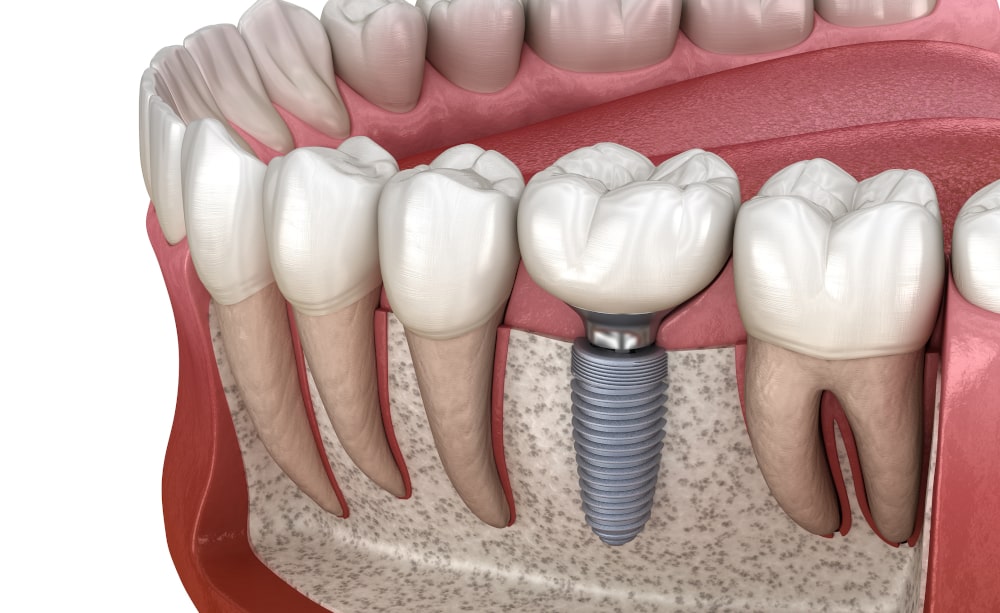
Dental Implants Guide: Everything You Need to Know
Missing a tooth? You’re not alone. According to studies conducted by the American College of Prosthodontists, roughly 178 million Americans lack at least one tooth. An astonishing 40 million US residents have lost all of their teeth. And because your smile is one of the first things people notice, it’s easy to see why a missing tooth can be a big deal.
But there’s more to missing teeth than just aesthetics. Alignment issues, increased risk of infection, TMJ problems, and uneven wear are just some of the many potential risks of leaving that gum space unoccupied. And while there are lots of types of restoration available, the dental implant is proving to be one of the most ideal. Learn the truth about dental implants here.
What is a Dental Implant?
Its name leaves little to the imagination. A dental implant is essentially an appliance that’s implanted into the gum and in contact with the jaw bone to replicate the function and performance of an actual tooth. Each implant is uniquely designed to match every patient’s unique case.
An implant is made up of three parts. These include the post, the abutment, and the crown. Implanted into the gum is the post. This metal appliance makes direct contact with the jaw bone and fuses with it in a process called osteointegration to give the tooth a more stable hold.
The abutment is something of a metal connector that links the post with the crown. The purpose of the abutment is to make it easier for dental care practitioners to easily perform any necessary, cleaning, or crown replacements in the future.
And then of course, there’s the crown. This is the false tooth itself, and will mostly be the only part of the dental implant that can be seen when you smile. They’re fashioned to match the rest of your teeth in both size, color, and shape, and are designed to function as well as any other tooth.
How Are Dental Implants Installed?
The dental implant procedure follows a specific set of steps to ensure the safety and success of the process. While some dental clinics may incorporate their own unique strategies, you can expect generally the same methods across the board.
Assessment and Patient Interview
Getting a dental implant is most often an invasive procedure, so your doctor will have to perform an in-depth assessment to determine your fitness for an implant.
During this time, they’ll collect all the necessary information to guarantee your safety throughout the process. With that, it’s likely that they’ll look into your medical history including whether you have any conditions like hypertension, or bleeding disorders that could affect the healing process.
Another thing they’ll evaluate is the quality of the bone at the site of the implant. If there’s insufficient bone density, they may have to perform a preliminary procedure called bone grafting. This involves taking a section of bone from a part of your body, or using a specialized bone grafting material.
This could take between two weeks and six months to completely heal. If a bone graft isn’t necessary, then your dentist will go straight to measuring your tooth, taking X-rays and other necessary imaging studies, and preparing the necessary materials for the procedure. You’ll then be scheduled for your surgery appointment.
Grafting
Dentists decide on the ideal anesthesia on a case-to-case basis. Local anesthetic may be used for mini dental implants, or if a patient is getting just one tooth replaced. For multiple replacements or full mouth dental implants, a general anesthetic may be required.
In some cases, clients who feel agitated and anxious may also do better under a generalized anesthetic since they will need to lay motionless and calm to ensure a safe procedure.
If a partial or broken tooth remains at the site of the implant, then it’s necessary to extract the tooth first. If too much bone is lost during the extraction, then your dentist may perform an alveolar bone graft to replace the lost bone. Again, this should be given time to heal prior to the implant.
If there’s not enough bone density at the site of the implant, then an onlay bone graft will be the method of choice. This could take up to six months to completely heal, depending on the patient.
For maxillary implants -- or those installed into the upper jaw -- it may be necessary to perform a sinus augmentation. The presence of the maxillary sinus which is an air-filled space in the bones of that area can limit the amount of bone available to install an implant.
The sinus augmentation raises the sinus floor and allow dentists to graft more bone for a stronger implant base. But if a tooth extraction goes according to plan and the bone beneath has enough density for the implant, then an immediate implant placement may be performed.
Surgery
Once your dentist is certain that there’s adequate, sturdy bone available for the implant, or that your graft has sufficiently healed, then it’s time for dental implant surgery. The gum tissue is cut to provide room for the post which is then drilled into the underlying bone.
They then place a healing cap over the post, and stitch up the gums to seal them over the implant. After this, the healing phase begins and the post is given time to osteointegrate with the bone underneath. This could take up to six months depending on how fast the individual heals.
If desired, the dentist may place a temporary denture to conceal the missing tooth. You might also have to come back on a routine basis to have the site checked and ensure that it’s healing properly.
After the healing time, the post is tested for integrity and stability to make sure that it has effectively fused with the bone. Upon passing this test, the post is then exposed by cutting away the superficial gum, and the abutment is screwed in place. The crown is then installed, thus completing the implant process.
Types of Dental Implants
There are various types of dental implants, distinguished by the number of teeth they replace, the material they use, or where on the jaw bone they connect.
Single tooth
Replaces a single missing tooth. The implant and abutment connect to one crown that replicates the appearance and function of one tooth.
Implant supported bridge
This option replaces three or more teeth. Two implants on either end connect to crowns with one or more teeth in between. The end teeth fix to an implant post, while the others in the middle simply float over the gumline like a bridge.
Implant supported dentures
These dentures fix to the gums by way of implants. They look like dentures, but they differ in that they stay in place by way of several implant posts.
Endosteal
This is the most common type of implant and fixes to your jaw bone by a process called osteointegration.
Superiosteal
Instead of fusing with the bone, the end of the implant post rests just on top of the bone.
Zygomatic
This is the most complicated and is only performed when there isn’t enough bone in the jaw. The implants are installed into the cheekbone, ensuring stability but requiring significant skill and time.
In terms of material, most dental implants use titanium posts which are lightweight yet durable. Ceramic implants are available to those who might be sensitive to metals. The crown itself however is often fabricated from porcelain or ceramic to give it a more realistic appearance.
Why Dental Implants?
There are lots of different kinds of dental restorations, including dentures, bridges, and crowns. But more and more patients are turning to implants despite their steeper cost because of the many benefits they provide. These include:
Natural look and performance
Perhaps one of the biggest reasons for the rise in the popularity of dental implants is because they look and feel more natural than any other type of restoration.
The direct link between the post and the jaw bone means that pressure is directed to the bone with every bite and chew, just like real teeth. This is incredibly different from the performance of crowns and dentures that take the brunt of the pressure, thus putting them at significant risk of damage.
And this altered feedback also means that individuals who use dentures and crowns tend to change the way they chew to prevent breaking their restoration, leading to an unnatural bite, TMJ pain, and uneven wear on their existing teeth.
Easy Maintenance
How do you take care of an implant? Well, pretty much the same way you would care for your actual teeth. Dentists recommend using a soft bristle brush and low-abrasive toothpaste to prevent scratches to your implant.
But other than that, you can pretty much floss around it, brush it, and use mouthwash as you would with your regular teeth. This makes the cleaning process much less taxing than dentures which require a cleaning process of its own.
Bone Loss Prevention
Notice how a person with missing teeth tends to look different over time. This bone loss happens because nothing is rooted, so to speak, against the jaw bone.
Over the years, the bone recesses and the face begin to sag. This is something that even traditional dentures, crowns, and bridges can’t fix because they don’t have a direct connection with the bone itself.
That’s also why dental implants are preferred for those who wish to prevent this bone loss. By rooting against the jaw bone, implants prevent bone loss and reduce the chances of facial sagging and other aesthetic issues associated with bone loss.
Alignment
The thing about teeth is that they will move around when there’s no reason for them to crowd together. So, when an empty space shows up, you can expect the rest of your teeth to move away from each other as they occupy the gap.
Bridges and dentures don’t really do anything to physically fill a gap, and instead, just cover up the empty space. With an implant however, the crown sits in and occupies the space so that neighboring teeth can’t muscle their way in.
Lasting
When installed by an experienced dental surgeon, a dental implant can last up to a lifetime. This is astonishingly long compared to dentures that average 7 to 10 years, or bridges that max at out 15.
Keep in mind though that the crown itself may become damaged with wear and tear. But because the post is implanted and fixed to your jaw bone, the crown replacement shouldn’t be too much of a chore.
Do Dental Implants Have Downsides?
Of course, there are a few dental implants problems and downsides that you might encounter along the way. These include:
Dental Implants Cost
This is almost always the biggest issue that people have with dental implants. Toronto dental implants cost an average of $1,600 per tooth. More affordable clinics can provide them at just around $1,000 per implant, while high-end clinics can stretch the dental implant cost up to $5,000 each.
Another thing is that they’re typically not covered by insurance, unless the procedure is required to reduce a medical risk. When you consider however that an implant can last a lifetime with basic care and maintenance, it’s easy to see that they’re definitely an investment.
Lengthy procedure
Taking a look at the whole process, it’s easy to see that getting an implant could take over a year for successful completion. That becomes even longer if a patient requires multiple grafts and preliminary procedures.
On average though, clinical studies have found that dental implant procedures have a success rate between 95% to 98%. So, you can be almost certain that after all the waiting, your implant will be completely healed and ready to use.
Risk of infection
This rings true with any surgical procedure. According to studies, four to 10% of patients who undergo a dental implant procedure develop postoperative infections. Fortunately, any dentist offering implants should be well-equipped to address and resolve any infections occurring throughout the process.
Discomfort
Are dental implants painful? Definitely not during the procedure since you will be placed under anesthetic. But the healing process may cause some discomfort and pain especially during the first three to five days. During this time, your dentist will provide pain medication to help you cope with the discomfort.
Something to Smile About
Your smile is one of the first things people notice, but there’s so much more to a complete smile than just aesthetics. Your teeth play a vital role in maintaining good oral health, so it’s important to replace damaged or lost teeth to keep your health in top condition.
Dental implants have been the golden standard for teeth replacement since the 1950’s, and for good reasons. So, if you’re looking to fill the gap with the best dental implants, the BarrieSmile Centre offers world-class dental implant procedures at the hands of some of the most experienced dental surgeons in the area. Give them a call today to find out more about their dental implant procedures.

See what our patients are saying:
The Barrie Smile Centre is the best dental office I've ever been to. The staff is very friendly,professional and knowledgeable. They take away any anxiety and fear of going for a procedure. I highly recommend them!
Very clean, professional and friendly! They have done lots of work for me including 2 implants. I highly recommend them!
Very clean, professional and helpful. 2 other dentists previously tried to fix my composite veneer and both times it look awful and/or was the wrong colour. One trip here and everything was fixed!
Very friendly, helpful staff. Makes you feel welcome as soon as you enter. I needed a tooth removed and got in the same day I called. When I arrived I didn’t have to wait. I have numerous problem with my teeth and they came up with a solution. Thank you all so much.
Just got home from the Smile Centre and I'm thrilled with my results. Had Zoom whitening, and it was better than I expected. The attendant took the time to explain everything super thoroughly. She warned I may have sensitivity but so far so good. I wish I did it ages ago.
The first thing I noticed upon entering the building was the beautiful design plan and lovely staff. I was greeted at the door and made comfortable throughout my entire experience. Everything was explained to me in detail and the staff always made sure I fully understood. This is an amazing office and I would 10/10 recommend it!!
Amazing fast clean attentive friendly ! Im sold! Thankkk youuuuu guys !!!!!!! Had a wisdom.tooth taken out under sedation! All.went perfect and you guys were awesomee!
Every time I go to the Smile Centre in Barrie it’s an amazing experience! Everyone from the admin staff to the dentists are so helpful. Not only do they tell you your options (in my case options for a missing tooth), but they also explain the pros and cons of every option. I highly recommend the Smile Centre
Barrie Smile Centre is truly amazing I called and had an issue with with some tooth pain they were able to fit me in same day which I was truly grateful for. All the staff are kind and professional they truly care about there patients. Big thank you to Dr.Eisen for being so kind and helping me in this situation. I highly recommend Barrie Smile Centre 😃 Thanks again
Great family dentist, has always been on time for appointments. Doing a great job during these times with cleanliness as well! Very professional staff!

